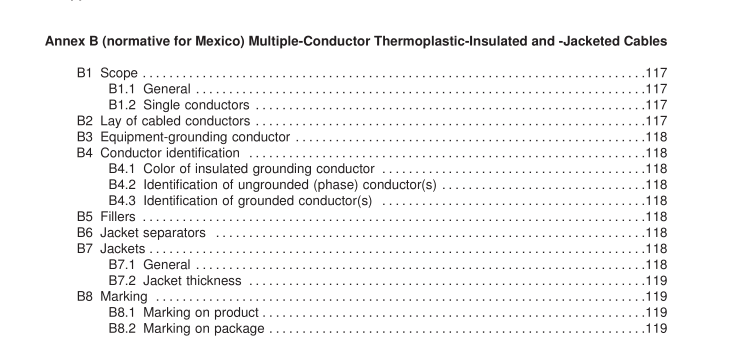UL 83-2008 pdf download.Thermoplastic-Insulated Wires and Cables.
4.1 .5 Sizes and stranding 4.1 .5.1 Sizes Conductors shall be as shown in Table 1 . Note: IEC conductor sizes are not recognized in the CEC, NEC, or NOM-001 -SEDE; however, these sizes may be required for wires and cables intended for use outside of the codes. As a guide to users of this Standard, information on IEC conductors is provided in Annex F. 4.1 .5.2 Stranding 4.1 .5.2.1 General The minimum number of wires (strands) in a conductor shall be in accordance with Table 2. Copper strands smaller than 0.01 27 mm 2 (36 AWG) and aluminum strands smaller than 0.324 mm 2 (22 AWG) shall not be used. A compact- stranded conductor shall not be segmented. 4.1 .5.2.2 Compact A compact-stranded conductor shall be a round conductor consisting of a central core surrounded by one or more layers of helically laid wires, and formed into a smooth outermost layer by rolling, drawing, or other means. The lay length of every layer shall be not less than 8 times nor more than 1 6 times the outside diameter of the completed conductor, except that for sizes 33.6 mm 2 (2 AWG) and smaller, the maximum lay length shall be 1 7.5 times the outside diameter. The direction of lay of the outermost layer shall be left-hand, and it shall be reversed or unidirectional/unilay in successive layers. 4.1 .5.2.3 Compressed A compressed-stranded conductor shall be a round conductor consisting of a central core surrounded by one or more layers of helically laid wires with either the direction of lay reversed in successive layers or unilay or unidirectional lay. The direction of lay of the outer layer shall be left-hand in all cases. The strands of one or more layers shall be slightly compressed by rolling, drawing, or other means to change the originally round strands to various shapes that achieve filling of some of the spaces originally present between the strands.
4.1 .5.2.4 Assembly of strands A 1 9-wire combination round-wire unilay stranded conductor shall be round and shall consist of a straight central wire, an inner layer of six wires of the same diameter as the central wire, and an outer layer consisting of six wires with the same diameter as the central wire alternated with six wires with a diameter of 0.732 times the diameter of the central wire. No particular assembly of the individual wires of any other stranded conductor shall be required. However, simple bunching (untwisted strands) shall not be used. The length of lay of the strands in a bunch-stranded conductor twisted as a single bunch shall not be greater than as indicated in Table 3. The direction of lay of the strands in a bunch-stranded conductor shall be left-hand. 4.1 .5.2.5 Length and direction of lay Every stranded conductor other than a compact-stranded conductor or a bunch-stranded conductor twisted as a single bunch shall comply with the following: a) The direction of lay of the strands, members, or ropes in a 1 3.3 – 1 01 0 mm 2 (6 AWG – 2000 kcmil) conductor, other than a combination unilay or a compressed unilay or compressed unidirectional lay conductor, shall be reversed in successive layers. Rope-lay conductors with bunch-stranded or concentric-stranded members shall be either unidirectional or reversed. All unidirectional lays and the outer layer of reversed lays shall be in the left-hand direction. b) For a bunch-stranded member of a rope-lay-stranded conductor in which the members are formed into rope-stranded components that are then cabled into the final conductor, the length of lay of the individual members within each component shall not be more than 30 times the outside diameter of one of those members.UL 83-2008 pdf download.
UL 83-2008 pdf download
